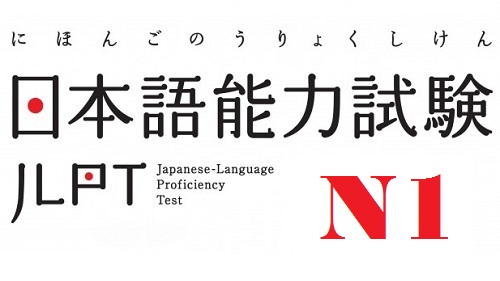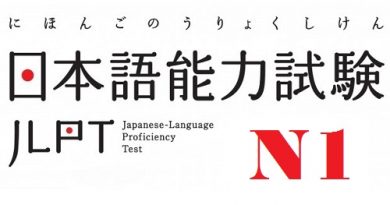JLPT N1 grammar lesson 4

JLPT N1 grammar lesson 4. Hi everyone! In this article, LearnJapanesedaily will introduce to you the JLPT N1 Grammar. Each lesson will consist of about 5 structures for you to learn step by step and have more time to practise.
Contents
JLPT N1 grammar structure 16 :
~ もさることながら
Formation :
[名] + もさることながら
Explanation :
“more over, plus…”.
To emphasize the second/latter part, while confirming/agreeing with the before-mentioned part.
Examples and meanings :
1. この作家が書くものは、鋭い(するどい)感性もさることながら、注意深(ちゅういぶか)く 選ばれた語彙と分の運び方が素晴らしい。
What the write writes, more than his way of conveying thoughts is his wonderful choice of words and his way with phrases.
2. その国では、観光もさることながら、伝統的な工芸品 (こうげいひん) の買い物が楽しめる。
In that country, beside enjoying the landscapes, shopping for traditional crafts is even more interesting.
JLPT N1 grammar structure 17 :
~ なり・・・ なり
Formation :
[名](+ 助詞)/ [動] 辞書形 + なり
Explanation :
「AなりBなり」 means “A is cool while B is okay”. A and B are words/phrases in the same group of meaning/related to each other. The latter part is opinion, wish of the speaker. Past tense is not used in this structure.
Examples and meanings :
1. 昼休みは40分しかないんだから、おにぎりなりサンドイッチなり何か買って早く食べたほうがいい。
We only have 40 minutes for lunch break so rice book is cool while sandwich is okay, you should buy something and eat it soon.
2. お手伝いできることはいたしますよ。私になり兄になり言ってください。
We will do anything in our power to help. If there’s anything you need tell me or my brother.
JLPT N1 grammar structure 18 :
~ であれ・・・ であれ・~ であろうと・・・ であろうと
Formation :
[名] + であれ/ であろうと
Explanation :
「AであれBであれ」/「AであろうとBであろうと」means “whether A or B the result is still the same”. A and B are words/phrases in the same group of meaning/related to each other.
Examples and meanings :
1. 地震であれ火事であれ、緊急(きんきゅう) の場合に冷静(れいせい) になれる人は少ないだろう。
Whether it is an earthquake or a fire, in emergency situations very few people can remain calm.
2. 文学であれ音楽であれ、芸術(げいじゅつ) には才能が必要なのだ。努力だけではだめなのだ。
Whether it is literature or music, when it comes to art talents are always required. Efforts alone aren’t enough.
JLPT N1 grammar structure 19 :
~ といい・・・ といい
Formation :
[名] + といい
Explanation :「AといいBといい」means “when looking at A and B there is a same condition (in every way…)”.A and B are words/phrases in the same group of meaning/related to each other. The latter part is opinion, judgment of the speaker.(often in adjectives)
Examples and meanings :
1. この映画は映像の美しさといい音楽の素晴らしさといい、最高の作品だ。
This movie is beautiful both in graphics and soundtracks, what a masterpiece.
2. 中島さんといい松本さんといい、うちの課の人はみんな話が面白い。
Like Nakajima and Matsumoto, everyone in my room has their way with words.
JLPT N1 grammar structure 20 :
~ いかん
Formation 1:
名 + いかんだ/ いかんで (は)。
Explanation :
“Depend on../decided by../based on..”
Examples and meanings :
1. 世界選手権(せんしゅけん)大会をこの国で開催できるかどうかは、国民の協力いかんだ。
Whether or not the world championship is held at this country is based on the coordination of the people.
2. 筆記試験(ひっきしけん)はパスした。あしたの面接の結果いかんで採用(さいよう)が決まるそうだ。
I skipped the writing test. People say the hiring result will be based on the interview tomorrow.
Formation 2:
名 + (の)+ いかんにかかわらず・いかんによらず
名 + の + いかんを問わず
Explanation
“not depend on../not decided by.. or affected by…/regardless “
Examples and meanings :
1. 内容のいかんにかかわらず、個人情報(こじんじょうほう)の問い合わせにはお答えしておりません。
Regardless of the content, we do not respond to inquiries about personal information
2. 明日の試合の結果いかんよらず、優勝できないことは決まってしまった。
Regardless of how tomorrow’s match might turn out, we can’t win anyway.
Above are the JLPT N1 Grammar lesson 4. Remember to read carefully and make up your own examples to memorize better.
If there is anything that you find it hard to understand, feel free to comment below!
Check out other JLPT N1 Grammar lessons in section: JLPT N1 Grammar
